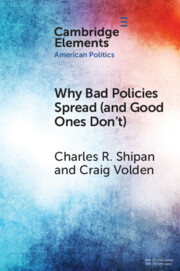Element contents
Why Bad Policies Spread (and Good Ones Don't)
Published online by Cambridge University Press: 02 September 2021
Summary
- Type
- Element
- Information
- Series: Elements in American PoliticsOnline ISBN: 9781108956123Publisher: Cambridge University PressPrint publication: 23 September 2021
References
- 13
- Cited by



